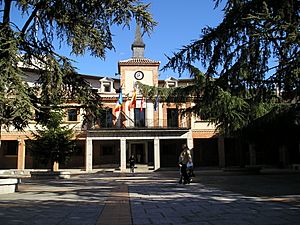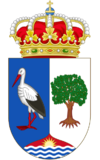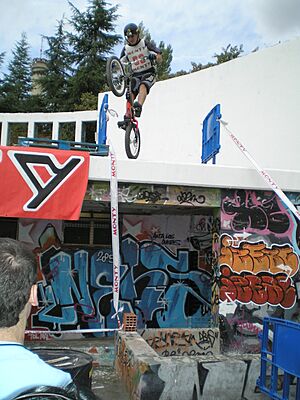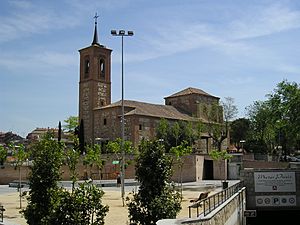Las Rozas de Madrid facts for kids
Quick facts for kids
Las Rozas de Madrid
|
|||
|---|---|---|---|

Ayuntamiento (Town Hall) of Las Rozas
|
|||
|
|||
| Country | Spain | ||
| Region | Community of Madrid | ||
| Government | |||
| • Type | Ayuntamiento | ||
| • Body | Ayuntamiento de Las Rozas de Madrid | ||
| Area | |||
| • Total | 59.14 km2 (22.83 sq mi) | ||
| Elevation | 718 m (2,356 ft) | ||
| Population
(2018)
|
|||
| • Total | 95,550 | ||
| • Rank | 1st | ||
| • Density | 1,615.66/km2 (4,184.5/sq mi) | ||
| Demonym(s) | roceño (m), roceña (f) | ||
| Time zone | UTC+1 (CET) | ||
| • Summer (DST) | UTC+2 (CEST) | ||
| Postal codes in Spain |
28230 - 28231 - 28232 - 28290
|
||
| Area code(s) | 34 (Spain) + 91 (Madrid) | ||
| Patron Saint | San Miguel Arcángel | ||
| Twinned with Granada and, Masaya, Nindirí, Villebon-sur-Yvette | |||
Las Rozas de Madrid, often called Las Rozas, is a town in Spain. It is located in the Community of Madrid. The town covers an area of about 59 square kilometers (22¾ sq. mi.).
Las Rozas is served by three Renfe train stations: Las Rozas, Pinar de Las Rozas, and Las Matas. It shares borders with other towns like Torrelodones to the north and Majadahonda to the south. The town is known for having one of the highest average incomes in the Madrid region.
In recent decades, Las Rozas has grown a lot. Many new homes were built, and its population more than doubled between 1991 and 2005. This growth sometimes made it hard for local services like schools to keep up. However, by 2010, the town had good services for health, education, and social needs.
Contents
A Look at Las Rozas History
The name "Rozas" means "clearings" in Spanish. There are different ideas about where the name came from. It might refer to clearings made by Romans for military training. Or it could be about gathering firewood or creating farmland. Some historians think Las Rozas might be the ancient city of Miacum, which was linked to Madrid around the third century.
Las Rozas is located near the Guadarrama River. It is also close to an old road that connected Segovia and Titulcia. This old road is now roughly where the A6/M505 routes are.
Las Rozas During the Spanish Civil War
During the Spanish Civil War, Las Rozas was a site of major battles. You can still see concrete bunkers from this time in the Dehesa of Navalcarbón. These bunkers are also found along the Guadarrama River valley.
In the winter of 1936, troops supporting Franco moved towards Madrid from the west. In thick fog and freezing weather, they fought against the republican forces. This was one of the bloodiest battles of the war. Many people from Las Rozas, called roceños, hid in nearby mountain caves. They were nicknamed cucos, meaning "the sly ones."
After the war, much of Las Rozas was destroyed. Out of 270 houses, only 13 were still standing. The government created a special group to rebuild towns ruined by the war. Las Rozas was one of the towns chosen for this rebuilding effort.
Getting Around Las Rozas
You can reach Las Rozas by several major roads. These include the Autopista del Noroeste (North-west Freeway) and the N-VI National Road. The M-50, which is a ring road around Madrid, also connects to the town.
There are also many bus lines that link Las Rozas to Madrid. These buses connect different parts of the town, including new areas like the Business Park. Another bus line connects Las Rozas to Aluche in Madrid.
Las Rozas has three main train stations. They are Las Rozas, Las Matas, and Pinar de Las Rozas. Train lines connect these stations to major points in Madrid, like Atocha and Chamartín. There is also a circular train line that serves Las Rozas.
There are plans to encourage more eco-friendly transport in Las Rozas. This includes ideas for electric scooters and "park and ride" facilities. These facilities would help people access shops and commute to Madrid.
Las Rozas and the Movies
In the 1960s, Las Rozas became a place for making movies. A famous film producer named Samuel Bronston built a large studio near Las Matas. This studio was meant to be one of the biggest in the world. However, some movies, like 55 Days at Peking, did not do well. This stopped Las Rozas from becoming a major film hub.
For the movie 55 Days at Peking, many local people worked as extras. They also helped build the movie sets. It is said that an artificial river was built and filled with water for the film.
A road in the Dehesa of Navalcarbón is named after Samuel Bronston. He wanted to be buried in Las Rozas, and his remains are now in the town's graveyard.
Culture and Fun in Las Rozas
Las Rozas offers many cultural activities. Most of these take place at the Joaquín Rodrigo Auditorium. This building also has a school for music and dance. The town has four cultural centers, three libraries, and five places for art exhibitions.
The town's official website lists many events. These include an annual Carnival and concerts of sacred music. There are also folk festivals and an international piano competition.
You can also find various themed street markets and fairs. In April, there's a fair celebrating horses. During the summer, there are seafood and tapas exhibitions. In the autumn, the [Festibike] international cycling event takes place.
Sports in Las Rozas
Sports are very important in Las Rozas. The town has won two national sports awards. This is partly because of its excellent training facilities.
Las Rozas has a football team called Las Rozas CF. They play in the Spanish Tercera División. There is also a futsal (indoor football) team.
The town also has a basketball team, CB Las Rozas. This team plays in the Spanish third level, called "LIGA LEB Plata". The club has more than 31 teams.
For over 15 years, Las Rozas has had a strong rugby team. They are called A.D Ingenieros Industriales. They play in the National First Division of Spanish Rugby. The Las Rozas Black Demons, an American Football team, also play here.
Another important sports facility is the Ciudad del fútbol. This is the "Football City" of the Royal Spanish Football Federation. It was built on land given by the Town Council.
Other popular local sports include Toad in the hole, Hammer throw, and Calva. Calva is a game similar to Horseshoes. Chito is another game where a diskus is thrown at a target with a coin on it.
Local Government in Las Rozas
The Town Hall of Las Rozas has 25 councillors. These councillors are chosen by public vote every four years. The mayor leads the town council.
After the elections in May 2023, the councillors are from different political parties:
|
Political parties in the Town Hall of Las Rozas 2023 |
||||
| Political parties | Councillors | |||
| PP |
|
|||
| Vox |
|
|||
| PSOE |
|
|||
| Más Madrid |
|
|||
Mayors of Las Rozas Since 1979
Since 2015, the mayor of Las Rozas has been José de la Uz Pardos. He belongs to the PP. His party currently holds a strong majority with 18 councillors.
| Mayor | Office started | Office ended | Party affiliation | ||||
| Benito Garrido Turrillo | April 1979 | October 1979 | PSOE |
||||
| Luis Schake de Miguel | October 1979 | May 1980 | PSOE |
||||
| Doroteo Lázaro Mingo | May 1980 | October 1981 | PSOE |
||||
| Luis Schake de Miguel | October 1981 | 1983 | PSOE |
||||
| Jesús Zúñiga Pérez-Lemaur | 1983 | 1995 | PSOE |
||||
| Bonifacio de Santiago Prieto | 1995 | 2011 | PP |
||||
| José Ignacio Fernández Rubio | 2011 | 2015 | PP |
||||
| José de la Uz Pardos | 2015 | - | PP |
||||
Las Rozas Population Facts
Las Rozas has grown a lot over the years. In 2004, its population was 68,061 people. The town has a younger population compared to the wider Community of Madrid. This means a higher percentage of young people live here.
The town also has a good number of foreign residents. In 2004, about 103 out of every 1,000 people were foreigners. Most of these foreign residents were women.
When it comes to jobs, most people in Las Rozas work in the services sector. This includes jobs in shops, offices, and other service industries.
Fun Festivals in Las Rozas
Las Rozas celebrates several popular festivals throughout the year:
- September 29: San Miguel Arcangel Day (St Michael Archangel). This day celebrates the town's patron saint. There are bullfights, concerts, huge paellas (a traditional Spanish dish), and fun contests.
- First Sunday of May: Virgin of the Retamosa. On this day, a statue of the Virgin of the Retamosa is carried in a parade. It goes from the Church of San Miguel Arcangel to a small chapel. Once there, a lively party with dancing and games takes place.
- May 1: San José Obrero (St Joseph the Worker), Labor Day. This festival is celebrated in the Las Matas area. It also features bullfights and concerts.
- January 6: Epiphany Bonfire. At midnight on Epiphany, young people used to light a big bonfire. This tradition was for young men about to start military service. However, as military service is no longer required, this tradition is slowly fading. The bonfire location has also moved several times due to new buildings.
See also
 In Spanish: Las Rozas de Madrid para niños
In Spanish: Las Rozas de Madrid para niños








